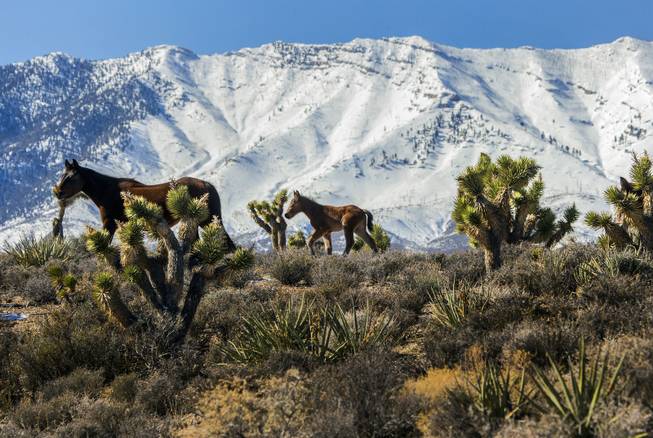
Wild horses make their way through the Spring Mountains rangeland near Cold Creek Feb. 28, 2017. Lead concentrations more than 30 times above safe levels have been identified in the soil of some portions of Lovell Canyon. Activists believe that unauthorized target shooting in the area is to blame.
Saturday, June 1, 2019 | 11:47 a.m.
Lead concentrations more than 30 times above safe levels have been identified in the soil of some portions of Lovell Canyon, a hiking and recreational area in the Spring Mountains west of Red Rock Canyon.
The elevated lead concentrations were found around Lovell Canyon Road, the main thoroughfare in the canyon, according to the grassroots conservation group Save Lovell Canyon. The group’s activists believe that unauthorized target shooting in the area is to blame.
Members of Save Lovell Canyon and Save Red Rock, a nonprofit dedicated to preserving and enhancing Red Rock, collected and studied soil samples from five locations along Lovell Canyon Road in April. They found “astronomically high” levels of lead, a known neurotoxin and carcinogen, in certain areas, said Rob Mrowka, a senior scientist with the Center for Biological Diversity involved in the effort.
“There’s a definite health concern, probably analogous to eating lead-based paint,” Mrowka said.
Mrowka and others from Save Red Rock have observed unauthorized shooting in the area for years, prompting them to investigate lead concentrations in the soil. Most bullets still contain lead, which disperses into the environment after a bullet hits a hard surface, Mrowka said.
Shooting has been temporarily banned in the Lovell Canyon area for the last two and a half years, but “pop-up” shooting ranges are common, said Pauline van Betten, executive director of Save Red Rock who is also involved in Save Lovell Canyon.
“We suspected there were going to be high lead levels,” van Betten said.
Uncontaminated soil typically contains a lead concentration below 50 parts per million (ppm). The Environmental Protection Agency says that bare soil in children’s play areas should not exceed a lead concentration greater than 400 ppm, and non-play areas should not exceed 1,200 ppm.
In parts of Lovell Canyon, unsafe lead concentrations in the soil range from 1,600 ppm to 44,000 ppm, according to the findings.
The heavy metal can remain in the environment indefinitely, trickling up the food chain and causing cancer and damage to the central nervous system in animals. It can also travel miles away from its source through winds.
“Anytime you start hearing about lead in the environment, flags go up. It’s not just about wildlife, but about possible human impacts,” Mrowka said.
Members of Save Lovell Canyon and Save Red Rock presented their lead findings to the U.S. Forest Service, which manages the Spring Mountains Recreational Area including most of Lovell Canyon, this week. Bill Dunkelberger, a forest supervisor with the U.S. Forest Service, said the federal agency plans to analyze and investigate the data.
Although the U.S. Forest Service typically permits hunting and shooting on its land, a ban on firearm shooting has been in place around Lovell Canyon because the agency has been evaluating the recreational area and conducting a master plan.
“We’re kind of looking at a couple questions: Is shooting appropriate, number one, and if it is, do we need to designate just one or two areas [for it]?” Dunkelberger said.
The Forest Service has three law enforcement officers in the Las Vegas area who patrol its land, including the Lovell Canyon area. But van Betten worries that enforcement efforts can’t keep up with the common practice of target shooting, which she said also puts campers and hikers at risk.
“You can’t tell people you can just go camp anywhere, and then also tell people they can just go shoot anywhere,” she said.
Save Red Rock and Save Lovell Canyon now hope to work with the Forest Service to remove the lead from the area and devise a plan to crack down on unauthorized shooting. Mrowka said that expanding authorized shooting ranges, in which lead bullets can be contained and removed from the environment, should be part of the path forward.
“We need to have a multi-agency approach to this. Part of the solution is providing safe [shooting] opportunities,” he said.
Shooting in unauthorized areas like Lovell Canyon has also started wildfires over the years, as some like to shoot explosive targets, Mrowka. He and van Betten added that they’ve observed damage to trees and flora as a result of shooting.
“It’s a problem that’s well beyond lead, but maybe lead is the most serious problem,” Mrowka said.
In response to the lead concentration findings, Save Red Rock, which has a much larger membership and reach than Save Lovell Canyon, plans to kick off a campaign specifically for Lovell Canyon, van Betten said.
All efforts to remedy the problem will include the U.S. Forest Service, which van Betten described as a “tremendous partner.”
“I think that we are now going to be looking at the situation holistically: How can we manage the canyon and keep it safe for all users?” she said.
